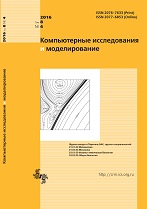|
This article is cited in 2 scientific papers (total in 2 papers)
MODELS IN PHYSICS AND TECHNOLOGY
Discrete-element simulation of a spherical projectile penetration into a massive obstacle
K. K. Abgaryana, A. A. Juravlevb, N. L. Zagordana, D. L. Reviznikovb
a Institution of Russian Academy of Sciences Dorodnicyn Computing Centre of RAS, 40 Vavilov st., Moscow,
119333, Russia
b Moscow Aviation Institute (National research University), 4 Volokolamskoye sh., Moscow, 125993, Russia
Abstract:
А discrete element model is applied to the problem of a spherical projectile penetration into a mas-sive obstacle. According to the model both indenter and obstacle are described by a set of densely packed parti-cles. To model the interaction between the particles the two-parameter Lennard-Jones potential is used. Com-puter implementation of the model has been carried out using parallelism on GPUs, which resulted in high spatial - temporal resolution. Based on the comparison of the results of numerical simulation with experimental data the binding energy has been identified as a function of the dynamic hardness of materials. It is shown that the use of this approach allows to accurately describe the penetration process in the range of projectile velocities 500-2500 m/s.
Keywords:
high velocity impact, discrete-element model, binding energy, numerical simulation.
Received: 23.12.2014
Citation:
K. K. Abgaryan, A. A. Juravlev, N. L. Zagordan, D. L. Reviznikov, “Discrete-element simulation of a spherical projectile penetration into a massive obstacle”, Computer Research and Modeling, 7:1 (2015), 71–79
Linking options:
https://www.mathnet.ru/eng/crm169 https://www.mathnet.ru/eng/crm/v7/i1/p71
|

| Statistics & downloads: |
| Abstract page: | 193 | | Full-text PDF : | 81 | | References: | 34 |
|




 Contact us:
Contact us: Terms of Use
Terms of Use
 Registration to the website
Registration to the website Logotypes
Logotypes









 Citation in format
Citation in format 
